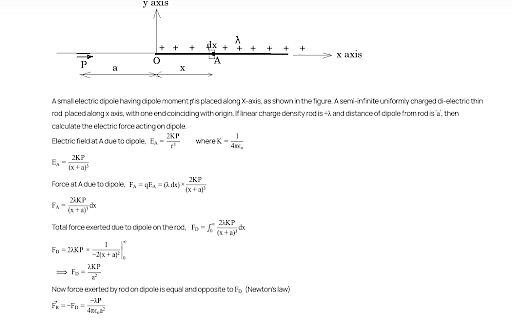Two electric dipoles, $A, B$ with respective dipole moments $\vec{d}_A = - 4 \,qa \,\hat{i}$ and $\vec{d}_B = - 2 \,qa\, \hat{i}$ placed on the x-axis with a separation $R$, as shown in the figure The distance from $A$ at which both of them produce the same potential is :
- $\frac{\sqrt{2}R}{\sqrt{2}+1}$
- $\frac{R}{\sqrt{2} +1}$
- $\frac{\sqrt{2}R}{\sqrt{2} - 1}$
- $\frac{R}{\sqrt{2} -1 }$
The Correct Option is C
Solution and Explanation
Top Questions on Electric Dipole
- An electric dipole of dipole moment \(6 \times 10^{-6} \) Cm is placed in a uniform electric field of magnitude \(10^6\) V/m. Initially, the dipole moment is parallel to the electric field. The work that needs to be done on the dipole to make its dipole moment opposite to the field will be ________________________ J.
- JEE Main - 2025
- Physics
- Electric Dipole
- An electric dipole of mass \( m \), charge \( q \), and length \( l \) is placed in a uniform electric field \( E = E_0 \hat{i} \). When the dipole is rotated slightly from its equilibrium position and released, the time period of its oscillations will be:
- JEE Main - 2025
- Physics
- Electric Dipole
- An electric dipole with dipole moment \(p = 5 \times 10^{-6}\) Cm is aligned with the direction of a uniform electric field of magnitude \(E = 4 \times 10^5\) N/C. The dipole is then rotated through an angle of \(60^\circ\) with respect to the electric field. The change in the potential energy of the dipole is:
- NEET (UG) - 2025
- Physics
- Electric Dipole
- Inside a closed surface, n electric dipoles are situated. The electric flux coming out from the closed surface will be
- Bihar Board XII - 2025
- Physics
- Electric Dipole
- The distance between two equal and opposite charges of \( 0.2 \mu C \) will be 3.0 cm. Their electric dipole moment will be
- Bihar Board XII - 2025
- Physics
- Electric Dipole
Questions Asked in JEE Main exam
Given below are two statements:
Statement (I):
 are isomeric compounds.
are isomeric compounds.
Statement (II): are functional group isomers.
are functional group isomers.
In the light of the above statements, choose the correct answer from the options given below:- JEE Main - 2025
- Isomerism
- Two projectiles are fired with the same initial speed from the same point on the ground at angles of \( (45^\circ - \alpha) \) and \( (45^\circ + \alpha) \), respectively, with the horizontal direction. The ratio of their maximum heights attained is:
- JEE Main - 2025
- Fluid Mechanics
Given below are two statements: one is labelled as Assertion \(A\) and the other as Reason \(R\):
Assertion \(A\): A sound wave has higher speed in solids than in gases.
Reason \(R\): Gases have higher value of Bulk modulus than solids.- JEE Main - 2025
- Fluid Mechanics
- Consider the following statements: Surface tension arises due to extra energy of the molecules at the interior as compared to the molecules at the surface of a liquid. As the temperature of liquid rises, the coefficient of viscosity increases. As the temperature of gas increases, the coefficient of viscosity increases. The onset of turbulence is determined by Reynolds number. In a steady flow, two streamlines never intersect. Choose the correct answer from the options given below:
- JEE Main - 2025
- Fluid Mechanics
In the experiment for measurement of viscosity \( \eta \) of a given liquid with a ball having radius \( R \), consider following statements:
A. Graph between terminal velocity \( V \) and \( R \) will be a parabola.
B. The terminal velocities of different diameter balls are constant for a given liquid.
C. Measurement of terminal velocity is dependent on the temperature.
D. This experiment can be utilized to assess the density of a given liquid.
E. If balls are dropped with some initial speed, the value of \( \eta \) will change.- JEE Main - 2025
- Fluid Mechanics
Concepts Used:
Electric Dipole
An electric dipole is a pair of equal and opposite point charges -q and q, separated by a distance of 2a. The direction from q to -q is said to be the direction in space.
p=q×2a
where,
p denotes the electric dipole moment, pointing from the negative charge to the positive charge.
Force Applied on Electric Dipole
